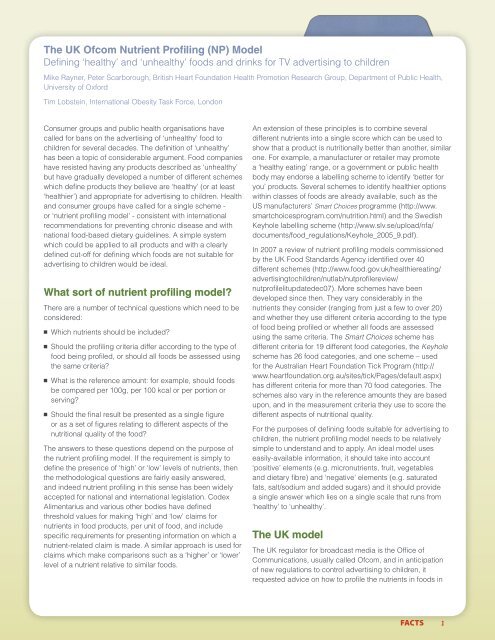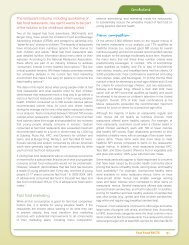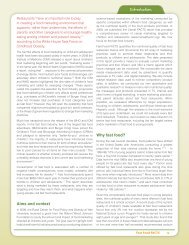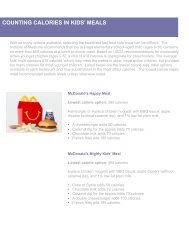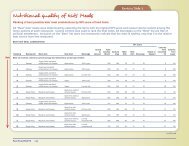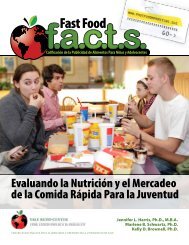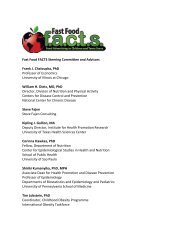What sort of nutrient profiling model? The UK ... - Fast Food FACTS
What sort of nutrient profiling model? The UK ... - Fast Food FACTS
What sort of nutrient profiling model? The UK ... - Fast Food FACTS
You also want an ePaper? Increase the reach of your titles
YUMPU automatically turns print PDFs into web optimized ePapers that Google loves.
<strong>The</strong> <strong>UK</strong> Ofcom Nutrient Pr<strong>of</strong>iling (NP) Model<br />
Defining ‘healthy’ and ‘unhealthy’ foods and drinks for TV advertising to children<br />
Mike Rayner, Peter Scarborough, British Heart Foundation Health Promotion Research Group, Department <strong>of</strong> Public Health,<br />
University <strong>of</strong> Oxford<br />
Tim Lobstein, International Obesity Task Force, London<br />
Consumer groups and public health organisations have<br />
called for bans on the advertising <strong>of</strong> ‘unhealthy’ food to<br />
children for several decades. <strong>The</strong> definition <strong>of</strong> ‘unhealthy’<br />
has been a topic <strong>of</strong> considerable argument. <strong>Food</strong> companies<br />
have resisted having any products described as ‘unhealthy’<br />
but have gradually developed a number <strong>of</strong> different schemes<br />
which define products they believe are ‘healthy’ (or at least<br />
‘healthier’) and appropriate for advertising to children. Health<br />
and consumer groups have called for a single scheme -<br />
or ‘<strong>nutrient</strong> pr<strong>of</strong>iling <strong>model</strong>’ - consistent with international<br />
recommendations for preventing chronic disease and with<br />
national food-based dietary guidelines. A simple system<br />
which could be applied to all products and with a clearly<br />
defined cut-<strong>of</strong>f for defining which foods are not suitable for<br />
advertising to children would be ideal.<br />
<strong>What</strong> <strong>sort</strong> <strong>of</strong> <strong>nutrient</strong> pr<strong>of</strong>iling <strong>model</strong>?<br />
<strong>The</strong>re are a number <strong>of</strong> technical questions which need to be<br />
considered:<br />
■ Which <strong>nutrient</strong>s should be included?<br />
■ Should the pr<strong>of</strong>iling criteria differ according to the type <strong>of</strong><br />
food being pr<strong>of</strong>iled, or should all foods be assessed using<br />
the same criteria?<br />
■ <strong>What</strong> is the reference amount: for example, should foods<br />
be compared per 100g, per 100 kcal or per portion or<br />
serving?<br />
■ Should the final result be presented as a single figure<br />
or as a set <strong>of</strong> figures relating to different aspects <strong>of</strong> the<br />
nutritional quality <strong>of</strong> the food?<br />
<strong>The</strong> answers to these questions depend on the purpose <strong>of</strong><br />
the <strong>nutrient</strong> pr<strong>of</strong>iling <strong>model</strong>. If the requirement is simply to<br />
define the presence <strong>of</strong> ‘high’ or ‘low’ levels <strong>of</strong> <strong>nutrient</strong>s, then<br />
the methodological questions are fairly easily answered,<br />
and indeed <strong>nutrient</strong> pr<strong>of</strong>iling in this sense has been widely<br />
accepted for national and international legislation. Codex<br />
Alimentarius and various other bodies have defined<br />
threshold values for making ‘high’ and ‘low’ claims for<br />
<strong>nutrient</strong>s in food products, per unit <strong>of</strong> food, and include<br />
specific requirements for presenting information on which a<br />
<strong>nutrient</strong>-related claim is made. A similar approach is used for<br />
claims which make comparisons such as a ‘higher’ or ‘lower’<br />
level <strong>of</strong> a <strong>nutrient</strong> relative to similar foods.<br />
An extension <strong>of</strong> these principles is to combine several<br />
different <strong>nutrient</strong>s into a single score which can be used to<br />
show that a product is nutritionally better than another, similar<br />
one. For example, a manufacturer or retailer may promote<br />
a ‘healthy eating’ range, or a government or public health<br />
body may endorse a labelling scheme to identify ‘better for<br />
you’ products. Several schemes to identify healthier options<br />
within classes <strong>of</strong> foods are already available, such as the<br />
US manufacturers’ Smart Choices programme (http://www.<br />
smartchoicesprogram.com/nutrition.html) and the Swedish<br />
Keyhole labelling scheme (http://www.slv.se/upload/nfa/<br />
documents/food_regulations/Keyhole_2005_9.pdf).<br />
In 2007 a review <strong>of</strong> <strong>nutrient</strong> pr<strong>of</strong>iling <strong>model</strong>s commissioned<br />
by the <strong>UK</strong> <strong>Food</strong> Standards Agency identified over 40<br />
different schemes (http://www.food.gov.uk/healthiereating/<br />
advertisingtochildren/nutlab/nutpr<strong>of</strong>ilereview/<br />
nutpr<strong>of</strong>ilelitupdatedec07). More schemes have been<br />
developed since then. <strong>The</strong>y vary considerably in the<br />
<strong>nutrient</strong>s they consider (ranging from just a few to over 20)<br />
and whether they use different criteria according to the type<br />
<strong>of</strong> food being pr<strong>of</strong>iled or whether all foods are assessed<br />
using the same criteria. <strong>The</strong> Smart Choices scheme has<br />
different criteria for 19 different food categories, the Keyhole<br />
scheme has 26 food categories, and one scheme – used<br />
for the Australian Heart Foundation Tick Program (http://<br />
www.heartfoundation.org.au/sites/tick/Pages/default.aspx)<br />
has different criteria for more than 70 food categories. <strong>The</strong><br />
schemes also vary in the reference amounts they are based<br />
upon, and in the measurement criteria they use to score the<br />
different aspects <strong>of</strong> nutritional quality.<br />
For the purposes <strong>of</strong> defining foods suitable for advertising to<br />
children, the <strong>nutrient</strong> pr<strong>of</strong>iling <strong>model</strong> needs to be relatively<br />
simple to understand and to apply. An ideal <strong>model</strong> uses<br />
easily-available information, it should take into account<br />
‘positive’ elements (e.g. micro<strong>nutrient</strong>s, fruit, vegetables<br />
and dietary fibre) and ‘negative’ elements (e.g. saturated<br />
fats, salt/sodium and added sugars) and it should provide<br />
a single answer which lies on a single scale that runs from<br />
‘healthy’ to ‘unhealthy’.<br />
<strong>The</strong> <strong>UK</strong> <strong>model</strong><br />
<strong>The</strong> <strong>UK</strong> regulator for broadcast media is the Office <strong>of</strong><br />
Communications, usually called Ofcom, and in anticipation<br />
<strong>of</strong> new regulations to control advertising to children, it<br />
requested advice on how to pr<strong>of</strong>ile the <strong>nutrient</strong>s in foods in<br />
<strong>FACTS</strong> 1
order to judge their suitability for advertising to children. In<br />
response, the <strong>UK</strong> <strong>Food</strong> Standards Agency commissioned the<br />
British Heart Foundation Health Promotion Research Group<br />
at Oxford University to carry out a research programme<br />
to develop a <strong>nutrient</strong> pr<strong>of</strong>iling <strong>model</strong>. <strong>The</strong> development <strong>of</strong><br />
the <strong>model</strong> has been well-documented elsewhere (http://<br />
www.food.gov.uk/foodlabelling/researchandreports/<br />
<strong>nutrient</strong>pr<strong>of</strong>iles). <strong>The</strong> <strong>model</strong> was formally passed to Ofcom<br />
at the end <strong>of</strong> 2005 and has subsequently been incorporated<br />
into a regulation (http://www.<strong>of</strong>com.org.uk/consult/condocs/<br />
foodads_new/statement). This prohibits advertising <strong>of</strong><br />
specified food and beverages during children’s programmes<br />
and programmes for which children under the age <strong>of</strong> 16<br />
years form a disproportionate part <strong>of</strong> the audience.<br />
In the development <strong>of</strong> the <strong>model</strong>, various prototypes<br />
were compared with each other and with a set <strong>of</strong> foods<br />
categorised for their compliance with healthy eating<br />
guidelines. This was first done relatively informally by a<br />
small ‘expert group’ consisting <strong>of</strong> academic nutritionists<br />
and representatives from industry, consumer organisations<br />
and public health bodies, but then more formally using an<br />
on-line survey <strong>of</strong> pr<strong>of</strong>essional nutritionists in the <strong>UK</strong>. <strong>The</strong><br />
survey asked the nutritionists to assess 40 foods for their<br />
‘healthiness’. <strong>The</strong> 40 foods were randomly drawn from<br />
120 different food products representative <strong>of</strong> the <strong>UK</strong> diet.<br />
<strong>The</strong> pr<strong>of</strong>essionals’ ratings were compared with the ratings<br />
obtained from the prototype <strong>model</strong>s (http://www.food.gov.uk/<br />
multimedia/pdfs/npreportsept05.pdf).<br />
<strong>The</strong> best prototype <strong>model</strong> showed a close correlation with<br />
the pr<strong>of</strong>essional ratings <strong>of</strong> r = 0.80 (95% CI 0.73-0.86). In this<br />
<strong>model</strong>, a single score based on a set <strong>of</strong> ‘negative’ indicators<br />
(energy, saturated fat, sugars and sodium) is counterbalanced<br />
by a score based on ‘positive’ indicators (protein,<br />
fibre and ‘fruit, vegetables and nuts’). <strong>The</strong> protein score was<br />
found to be a good indicator <strong>of</strong> a range <strong>of</strong> micro<strong>nutrient</strong>s<br />
that would otherwise merit inclusion in the <strong>model</strong>. All<br />
measurement criteria were per 100 grams. <strong>The</strong> final <strong>model</strong><br />
included various refinements to allow for some anomalous<br />
foods: in particular, the protein score was disallowed if the<br />
score for ‘fruit, vegetables and nuts’ was too low.<br />
<strong>The</strong> <strong>model</strong> generates a final single score which determines<br />
whether the food can be advertised to children. Two<br />
threshold levels were set: one threshold for all food products<br />
and another for beverages.<br />
Note that the <strong>model</strong> uses a 100g measure rather than<br />
actual serving size. This is justified on the basis that the<br />
<strong>model</strong> is designed to measure the nutritional quality <strong>of</strong> the<br />
food regardless <strong>of</strong> the way it is eaten. Using a 'per serving'<br />
approach would have been possible but to do so introduces<br />
several difficulties, not least <strong>of</strong> which is the fact that serving<br />
sizes and consumption patterns are an individual matter<br />
and cannot be standardised, especially across different age<br />
groups.<br />
Early prototypes <strong>of</strong> the <strong>model</strong> gave a score for added<br />
sugars (technically non-milk extrinsic sugars), but this was<br />
later replaced with a score for total sugar, a move which<br />
received substantial support from food manufacturers who<br />
said they faced technical difficulties in analysing added<br />
sugars and that information on total sugars is a requirement<br />
<strong>of</strong> <strong>UK</strong> (based on European) food labelling legislation. <strong>The</strong><br />
contribution <strong>of</strong> foods high in natural sugars to a balanced<br />
diet is addressed through the inclusion <strong>of</strong> criteria for protein<br />
(in which dairy products usually score well) and for fruit and<br />
vegetables.<br />
Early prototypes also gave scores for calcium, iron and n-3<br />
poly-unsaturated fatty acids. <strong>The</strong>se were later replaced with<br />
a score for protein, primarily to make scoring foods easier<br />
(protein levels are required by food labelling legislation but<br />
calcium, iron and n-3 polyunsaturated fatty acid levels are<br />
not) but also because prototype <strong>model</strong>s which gave a score<br />
for protein rather than the other three <strong>nutrient</strong>s gave similar<br />
results.<br />
Subsequent to the adoption <strong>of</strong> the <strong>model</strong> the British Heart<br />
Foundation Health Promotion Research Group have further<br />
investigated the validity <strong>of</strong> the <strong>model</strong> - and in particular have<br />
shown that people in the <strong>UK</strong> who have less healthy diets<br />
consume more <strong>of</strong> their calories in the form <strong>of</strong> foods defined<br />
as less healthy by the <strong>model</strong>.<br />
<strong>The</strong> <strong>model</strong> was developed for the regulation <strong>of</strong> food<br />
advertising in the <strong>UK</strong>, and was tested on a range <strong>of</strong> foods<br />
in <strong>UK</strong> national databases. For use outside the <strong>UK</strong> the <strong>model</strong><br />
should be assessed using relevant national food databases,<br />
and for international use it should be assessed on a broad<br />
range <strong>of</strong> products from different national cuisines.<br />
Added value and further applications <strong>of</strong><br />
<strong>nutrient</strong> pr<strong>of</strong>iling<br />
A clear result <strong>of</strong> using <strong>nutrient</strong> pr<strong>of</strong>iling as a means <strong>of</strong><br />
assessing eligibility for marketing is that the pr<strong>of</strong>iling scheme<br />
becomes a driver for product reformulation. Processed<br />
foods that fail to meet the criteria permitting their advertising<br />
to children might benefit from reformulation, enabling the<br />
manufacturer to continue to advertise them. For example,<br />
most breakfast cereals promoted on children’s television are<br />
high in sugar, and some are also high in salt. It is hoped that<br />
the controls in marketing may stimulate manufacturers to<br />
produce products that are lower in sugar and salt, thereby<br />
avoiding the advertising restrictions.<br />
Although developed for restrictions on marketing through<br />
broadcast media, the <strong>model</strong> also has the potential to be<br />
used as the basis for developing regulations for nonbroadcast<br />
advertising and promotion – for example for<br />
product placements in films or for internet advertising.<br />
<strong>FACTS</strong> 2
Nutrient pr<strong>of</strong>iling <strong>model</strong>s could clearly support a wide<br />
range <strong>of</strong> public health initiatives. <strong>The</strong>y are already used<br />
extensively as the basis <strong>of</strong> food labelling schemes. Note<br />
however that the front-<strong>of</strong>-pack ‘traffic light’ labelling scheme<br />
recommended for use by the <strong>UK</strong> <strong>Food</strong> Standards Agency<br />
uses a different <strong>nutrient</strong> pr<strong>of</strong>iling scheme than the one<br />
that has been developed for restrictions on marketing <strong>of</strong><br />
foods to children. <strong>The</strong> three ‘traffic light’ colours indicate<br />
high, medium and low levels, for each <strong>of</strong> four <strong>nutrient</strong>s: fat,<br />
saturated fats, sugars and salt/sodium. Nutrient pr<strong>of</strong>iling<br />
could also be used to support labelling in catering outlets,<br />
where, for example, traffic light signalling could help<br />
customers select healthier items from menus in advance <strong>of</strong><br />
ordering their food.<br />
In order to prevent poor quality foods from being promoted<br />
with health claims on the basis <strong>of</strong> a single ‘good’ ingredient,<br />
<strong>nutrient</strong> pr<strong>of</strong>iling can be used to decide if a food is<br />
sufficiently ‘healthy’ to be allowed to carry a health claim. <strong>The</strong><br />
government body responsible for health claims regulation in<br />
Australia and New Zealand (<strong>Food</strong> Standards Australia New<br />
Zealand) has adapted the <strong>UK</strong> Ofcom <strong>model</strong> for assessing<br />
whether foods should be allowed to carry health claims.<br />
<strong>The</strong>ir site includes a calculator that returns a score from<br />
the <strong>model</strong> (http://www.foodstandards.gov.au/foodmatters/<br />
healthnutritionandrelatedclaims/<strong>nutrient</strong>pr<strong>of</strong>ilingcal3499.<br />
cfm). <strong>The</strong> European Commission is also in the process <strong>of</strong><br />
developing a <strong>nutrient</strong> pr<strong>of</strong>iling scheme that would define<br />
which foods may carry a permitted nutrition or health claim.<br />
<strong>The</strong> use <strong>of</strong> <strong>nutrient</strong> pr<strong>of</strong>iling can be extended to contractual<br />
relationships: for example the quality criteria for products<br />
supplied for school meal services and institutional catering<br />
in the workplace. <strong>The</strong> health sector, armed service, prisons<br />
and elderly care could include nutritional pr<strong>of</strong>iling standards,<br />
which in turn could be used for contract compliance and for<br />
health impact assessments <strong>of</strong> meal service policies.<br />
Fiscal policies designed to benefit public health may, if they<br />
are considered appropriate, also benefit from using <strong>nutrient</strong><br />
pr<strong>of</strong>iling as an assessment tool. One criticism made <strong>of</strong> the<br />
suggestion to impose a tax on foods such as s<strong>of</strong>t drinks<br />
and snack foods is the difficulty <strong>of</strong> administering the tax<br />
because <strong>of</strong> the problem <strong>of</strong> defining what constitutes a s<strong>of</strong>t<br />
drink, a snack food, etc. Nutrient pr<strong>of</strong>iling provides a method<br />
for categorising foods for taxation or subsidy. A taxation<br />
system based on <strong>nutrient</strong> pr<strong>of</strong>iling would also encourage<br />
manufacturers to reformulate their recipes and adjust their<br />
product portfolio.<br />
<strong>The</strong> <strong>UK</strong> Ofcom <strong>nutrient</strong> pr<strong>of</strong>iling <strong>model</strong><br />
in detail<br />
<strong>The</strong> <strong>model</strong> provides a single score for any given food<br />
product, based on calculating the number <strong>of</strong> points for<br />
‘negative’ <strong>nutrient</strong>s which can be <strong>of</strong>fset by points for<br />
‘positive’ <strong>nutrient</strong>s. Points are allocated on the basis <strong>of</strong> the<br />
nutritional content in 100g <strong>of</strong> a food or drink.<br />
<strong>The</strong>re are three steps to working out the overall score for the<br />
food or drink.<br />
1. Calculate the total 'A' points<br />
A maximum <strong>of</strong> ten points can be awarded for each ingredient<br />
(energy, saturated fat, sugar and sodium). <strong>The</strong> total ‘A’ points<br />
are the sum <strong>of</strong> the points scored for each ingredient.<br />
Total 'A' points = [points for energy] + [points for saturated<br />
fat] + [points for sugars] + [points for sodium]<br />
Points Energy Sat Fat Total Sugar Sodium<br />
(kJ) (g) (g) (mg)<br />
0 ≤ 335 ≤ 1 ≤ 4.5 ≤ 90<br />
1 >335 >1 >4.5 >90<br />
2 >670 >2 >9 >180<br />
3 >1005 >3 >13.5 >270<br />
4 >1340 >4 >18 >360<br />
5 >1675 >5 >22.5 >450<br />
6 >2010 >6 >27 >540<br />
7 >2345 >7 >31 >630<br />
8 >2680 >8 >36 >720<br />
9 >3015 >9 >40 >810<br />
10 >3350 >10 >45 >900<br />
If a food or drink scores 11 or more 'A' points then it cannot<br />
score points for protein unless it also scores 5 points for fruit,<br />
vegetables and nuts.<br />
2. Calculate the total 'C' points<br />
A maximum <strong>of</strong> five points can be awarded for each<br />
ingredient. <strong>The</strong> total ‘C’ points are the sum <strong>of</strong> the points for<br />
each ingredient (note that you should choose one or other <strong>of</strong><br />
the dietary fibre columns according to how the fibre content<br />
<strong>of</strong> the food or beverage was calculated).<br />
Total 'C' points = [points for fruit, vegetables and nut content]<br />
+ [points for fibre (either NSP or AOAC)] + [points for<br />
protein]<br />
NB. Guidance on scoring fruit, vegetables and nut content<br />
is available from the <strong>Food</strong> Standards Agency (http://www.<br />
foodstandards.gov.uk/multimedia/pdfs/nutpr<strong>of</strong>pguide.pdf).<br />
<strong>FACTS</strong> 3
Points Fruit, Veg NSP Fibre or AOAC Protein<br />
& Nuts (%) (g) Fibre (g) (mg)<br />
0 ≤ 40 ≤ 0.7 ≤ 0.9 ≤ 1.6<br />
1 >40 >0.7 >0.9 >1.6<br />
2 >60 >1.4 >1.9 >3.2<br />
3 - >2.1 >2.8 >4.8<br />
4 - >2.8 >3.7 >6.4<br />
5 >80 >3.5 >4.7 >8.0<br />
3. Calculate the overall score<br />
If a food scores less than 11 'A' points then the overall score<br />
is calculated as follows:<br />
Overall score = [total 'A' points] minus [total 'C' points].<br />
If a food scores 11 or more 'A' points but scores 5 points for<br />
fruit, vegetables and nuts then the overall score is calculated<br />
as follows:<br />
Overall score = [total 'A' points] minus [total 'C' points]<br />
If a food scores 11 or more 'A' points but also scores less than<br />
5 points for fruit, vegetables and nuts then the overall score is<br />
calculated without reference to the protein value, as follows:<br />
Overall score = [total 'A' points] minus [fibre points + fruit,<br />
vegetables and nuts points only]<br />
<strong>The</strong> <strong>model</strong> can be adjusted to take account <strong>of</strong> changes<br />
in public health nutritional policy. Within the <strong>model</strong> any<br />
threshold can be defined according to the judgment <strong>of</strong> the<br />
Examples <strong>of</strong> foods that can and cannot be advertised according to the <strong>UK</strong><br />
Ofcom <strong>nutrient</strong> pr<strong>of</strong>iling <strong>model</strong><br />
policy makers and their scientific advisers. For the purposes<br />
<strong>of</strong> the advertising controls introduced in the United Kingdom:<br />
a food is classified as 'less healthy' where it scores 4 points<br />
or more, and<br />
a drink is classified as 'less healthy' where it scores 1 point<br />
or more.<br />
Frequently asked questions<br />
<strong>The</strong>re are a number <strong>of</strong> frequently asked questions about<br />
how to use the <strong>model</strong> to calculate scores for products. One<br />
<strong>of</strong> the most frequently asked questions is: ‘<strong>What</strong> counts as<br />
a food and what as a drink?’ For the purpose <strong>of</strong> the <strong>model</strong><br />
a drink is defined as 'any liquid food, excluding oils, soups,<br />
condiments (vinegar, salad cream etc.) and dressings.'<br />
Answers to other questions such as ‘Should scores be<br />
calculated for products as eaten or as sold?’, ‘How do you<br />
calculate the scores for foods where nutritional information<br />
is provided by volume rather than weight?’ and worked<br />
examples are available in technical advice provided by the<br />
<strong>Food</strong> Standards Agency (http://www.food.gov.uk/multimedia/<br />
pdfs/techguidenutpr<strong>of</strong>iling.pdf).<br />
<strong>The</strong> <strong>model</strong> can be adjusted so that points for foods and<br />
drinks fall on a scale from 1 to 100 where 1 is the least<br />
healthy and 100 is the most healthy product using a simple<br />
formula: NUTRITION PROFILING INDEX SCORE = (-2)*OLD<br />
SCORE + 70<br />
<strong>The</strong> table below gives an indication <strong>of</strong> how the <strong>model</strong><br />
categorises foods.<br />
<strong>Food</strong>s that can be advertised <strong>Food</strong>s that cannot be advertised<br />
(points
Annotated reading list about the <strong>UK</strong><br />
Ofcom <strong>nutrient</strong> pr<strong>of</strong>ile <strong>model</strong><br />
<strong>The</strong> history <strong>of</strong> the <strong>model</strong>.<br />
<strong>The</strong>se reports describe the development <strong>of</strong> the <strong>UK</strong><br />
Ofcom <strong>nutrient</strong> pr<strong>of</strong>iling <strong>model</strong>.<br />
1. Rayner M, Scarborough P, Stockley L. Nutrient Pr<strong>of</strong>iles:<br />
Options for definitions for use in relation to food<br />
promotion and children’s diets. London: <strong>Food</strong> Standards<br />
Agency, 2004. http://www.food.gov.uk/multimedia/pdfs/<br />
<strong>nutrient</strong>pr<strong>of</strong>ilingfullreport.pdf<br />
2. Stockley L. Report on a scientific workshop to assess<br />
the <strong>Food</strong> Standards Agency’s proposed approach to<br />
<strong>nutrient</strong> pr<strong>of</strong>iling. London: <strong>Food</strong> Standards Agency,<br />
2005. http://www.food.gov.uk/multimedia/pdfs/<br />
nutpr<strong>of</strong>workshop250205.pdf<br />
3. Rayner M, Scarborough P, Stockley L, Boxer A. Nutrient<br />
Pr<strong>of</strong>iles: Further refinement and testing <strong>of</strong> <strong>model</strong><br />
SSCg3d. London: <strong>Food</strong> Standards Agency, 2005. http://<br />
www.food.gov.uk/multimedia/pdfs/npreportsept05.pdf<br />
4. Rayner M, Scarborough P, Boxer A, Stockley L. Nutrient<br />
pr<strong>of</strong>iles: Development <strong>of</strong> final <strong>model</strong>. London: <strong>Food</strong><br />
Standards Agency, 2005. http://www.food.gov.uk/<br />
multimedia/pdfs/nutpr<strong>of</strong>r.pdf<br />
<strong>The</strong> <strong>model</strong> was agreed at a board meeting <strong>of</strong> the <strong>UK</strong><br />
<strong>Food</strong> Standards Agency held on 13th October 2005.<br />
See the minutes <strong>of</strong> this meeting. http://www.food.gov.uk/<br />
aboutus/ourboard/boardmeetings/boardmeetings2005/<br />
boardmeeting101305/boardminutes131005<br />
Ofcom agreed to use the <strong>model</strong> in February 2007. See<br />
Office <strong>of</strong> communications. Television Advertising <strong>of</strong> <strong>Food</strong> and<br />
Drink Products to Children Final statement. London: Ofcom,<br />
2007. http://www.<strong>of</strong>com.org.uk/consult/condocs/foodads_<br />
new/statement/statement.pdf<br />
In 2007 the <strong>UK</strong> <strong>Food</strong> Standards Agency set up an<br />
Independent Review Panel to assess ‘the effectiveness <strong>of</strong> the<br />
<strong>nutrient</strong> pr<strong>of</strong>iling <strong>model</strong> at differentiating foods on the basis<br />
<strong>of</strong> their <strong>nutrient</strong> composition’. As part <strong>of</strong> that review the BHF<br />
Health Promotion Research Group was commissioned to<br />
carry out a review <strong>of</strong> <strong>nutrient</strong> pr<strong>of</strong>iling <strong>model</strong>s. See:<br />
5. Stockley L, Rayner M, Kaur A . Nutrient pr<strong>of</strong>iles for use<br />
in relation to food promotion and children’s diet: Update<br />
<strong>of</strong> 2004 literature review. London: <strong>Food</strong> Standards<br />
Agency, 2008. http://www.food.gov.uk/healthiereating/<br />
advertisingtochildren/nutlab/nutpr<strong>of</strong>ilereview/<br />
nutpr<strong>of</strong>ilelitupdatedec07<br />
<strong>The</strong> Independent Review Panel finished its work in March<br />
2009. See the report <strong>of</strong> their review for a board meeting <strong>of</strong><br />
the <strong>UK</strong> <strong>Food</strong> Standards Agency <strong>of</strong> 25th March 2009. http://<br />
www.food.gov.uk/multimedia/pdfs/board/fsa090306v2.pdf<br />
At this meeting the <strong>UK</strong> <strong>Food</strong> Standards Agency accepted<br />
the finding <strong>of</strong> the Independent Review Panel ‘that the<br />
<strong>nutrient</strong> pr<strong>of</strong>iling <strong>model</strong> was generally scientifically robust<br />
and fit for purpose’ and considered that there was no need<br />
to modify the <strong>model</strong> for the time being. See the minutes <strong>of</strong><br />
this meeting. http://www.food.gov.uk/multimedia/pdfs/board/<br />
boardmins090325.pdf<br />
Papers on the <strong>model</strong> published in peer-reviewed<br />
journals<br />
Meanwhile the BHF Health Promotion Research Group has<br />
published a series <strong>of</strong> papers relating to the development <strong>of</strong><br />
the <strong>model</strong> and its validation. <strong>The</strong>se publications include the<br />
following:<br />
6. Rayner M, Scarborough P, Williams C. <strong>The</strong> origin <strong>of</strong><br />
Guideline Daily Amounts and the <strong>Food</strong> Standards<br />
Agency’s guidance on what counts as ‘a lot’ and ‘a little’.<br />
Public Heath Nutrition 2003: 7 (4); 549-556.<br />
7. Scarborough P, Rayner M, Stockley L. Developing<br />
<strong>nutrient</strong> pr<strong>of</strong>ile <strong>model</strong>s: a systematic approach. Public<br />
Health Nutrition 2007: 10; 330-336.<br />
8. Scarborough P, Rayner M, Stockley , Black A. Nutrition<br />
pr<strong>of</strong>essionals’ perception <strong>of</strong> the ‘healthiness’ <strong>of</strong><br />
individual foods, Public Health Nutrition 2007: 10; 346-<br />
353.<br />
9. Scarborough P, Boxer A, Rayner M, Stockley L. Testing<br />
<strong>nutrient</strong> pr<strong>of</strong>ile <strong>model</strong>s using data from a survey <strong>of</strong><br />
nutrition pr<strong>of</strong>essionals, Public Health Nutrition 2007: 10;<br />
337-345.<br />
10. Arambepola C, Scarborough M, Rayner M. Validating a<br />
<strong>nutrient</strong> pr<strong>of</strong>ile <strong>model</strong>, Public Health Nutrition 2008: 11;<br />
371–378.<br />
11. Arambepola C, Scarborough P, Boxer A, Rayner M.<br />
Defining ‘low in fat’ and ‘high in fat’ when applied to a<br />
food. Public Health Nutrition 2009: 12: 341-350.<br />
And other papers have discussed the <strong>model</strong> including:<br />
Azais-Braesco, V, G<strong>of</strong>fi, C, Labouze, E. Nutrient pr<strong>of</strong>iling:<br />
comparison and critical analysis <strong>of</strong> existing systems. Public<br />
Health Nutrition 2006; 9(5): 613–622.<br />
Lobstein T, Davies S. Defining and labelling 'healthy' and<br />
'unhealthy' food. Public Health Nutrition 2009: 12; 331-340.<br />
<strong>FACTS</strong> 5


